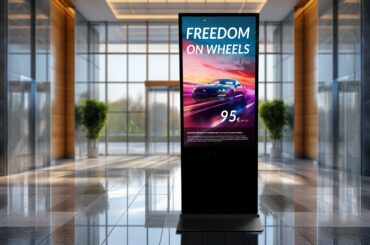“…almost eight in 10 (76 percent) American consumers enter a store they have never visited before based on its signs, and nearly seven in 10 (68 percent) have actually purchased a product or service because a sign caught their eye.”
– FedEx-
The first impression is the decisive factor. That’s no surprise and roundly known. A job interview, the first date or – even more special – your own shop window: if you’re not convincing, in the beginning, it’s hard to get a second chance. A chance that is now more important than ever in a time of simultaneously increasing branch expansion and decreasing brand loyalty.
But it’s not about watching and copying your nearby competitors. It’s quite the opposite: shopping windows represent the history of your own company, they tell who you are and need to get the pedestrians’ attention among thousands of other impressions to make them pause on their way.
And it’s getting even harder as floor lamps for smartphone user are being installed and the focus is hard to avert from mobile devices anymore. Quite a difficult task, but with digital window displays – not impossible.
Make your own shop interactive display window stand out against others. That’s the challenge retailers and department stores, bistros, and gastronomy, barber shops or travel agencies have to face – the very branch which presents its goods and services in a shopping window and so try to catch the pedestrians’ attention.
How and where could you get inspired and become a feeling about interesting window display ideas? Which of those will not only attract attention but also help nearly every customer to become the loyal one?
What’s distinctive: visual merchandising is boosting. And so does the shopping window. Numerical that means 20% of in-store communication is invested in the shopping window, according to a study from RHI Retail Institute Cologne, which is up to an annual amount of 80 Million Euro.
During a little stroll through the town, the trend is becoming apparent: sumptuously created shopping experiences in a row one after another, colorful accessories supporting the new collection or a minimalistic interior for a straight store design.
Whatever concept is the purpose of the design one trend is standing out: digital window displays. More and more companies are courting for the pedestrians’ attention by using framed video walls, large-sized displays and – even though still rarely – interactive shopping window solutions. The bigger, the better. Beeing conspicuous at any price.
Window display ideas
However, the digital window displays are not only made for attention-grabbing presentations. They create a whole range of new possibilities for customer communication and provide synergies between the digital and the real world. Read which advantages you will get through digital advertising in interactive shopping windows you in our 5 Reasons Why.
Best Practise | Adidas | Source: YouTube
1. Video – for a vivid, digital window display
Now we want to linger on a video as a great window display idea. It may sound corny but a picture is worth a thousand words. And yet videos are worth a thousand pictures.
They enliven shopping windows more than any usual poster does and put the advertised product or service in the limelight – with significant success: According to the Arbitron Digital Video Study 2010 nearly half of the interviewed customers (47%) which have seen a video in public during the last month could remember the shown advertising. Furthermore, almost every fifth (19%) stated to have already bought an unplanned product after seeing the digital advertising.
No matter if it’s an image film or a product video – movement in shopping windows doesn’t only support the presentation of goods it also involves walk-in customers and sales.
2. Call to Action – customer interaction that connects
Who already knows the term Call to Action, may have probably read this marketing buzzword in numerous internet blogs over the last years. Action hereby means a concrete demand for an interaction of the customer within a marketing promotion.
On the internet, this could be to fill out a contact form or to subscribe to a newsletter. Nevertheless, call to actions is not only limited to the online world. They are also well suitable for digital window displays.
Call to Actions can be used in many kinds of ways but should always point out a clear benefit for the pedestrian and furthermore should imply a certain urgency.
Interactive windows – unexpected promotions
90% of the “generation head down” are using their smartphone also while shopping. Therefore it’s obvious that the mobile part of the customer world should be added to the real world. QR-Codes, for example, would be such an opportunity (see video).
Pedestrians can scan these little cube patterns or labyrinths with their smartphones to get further product information or to receive coupons or sales discounts. Afterward, they enter the shop to redeem the coupon they just compiled themselves.
Only today. Scan the code and save 50%. Adidas, for example, clarifies that a creative digital window display can absolutely have a viral character.
3. Testimonials – from the internet to the shopping window
One essential part of amazon’s success? Customer reviews! They are very important for every online shop. The first impression counts – just as the appearance of the own store. Communication between customers makes them gain trust into the product, also seems reliable and it describes advantages for the use from the customers’ perspective.
Authentic customer reviews from consumers who bought the product and adjudge it after having used it themselves are a strong statement for your shopping window. It’s actually that strong, that 90% of customers get influenced by it in their buying decision according to a study by Dimensional Research.
Digital window displays allow you to show your latest customer reviews for specific products to have pedestrians developing trust in you and your product even before entering your store. Especially products and services which require more trust during the buyer’s journey.
4. Social Media – customer loyalty online and offline
More and more companies discover the integration of social network at the point of sale and encourage their customers and users to share their brand on Instagram, facebook, and others. And they are successful: duckface selfies, vacation and adventure photos alone make an amount of 70 million new posts on Instagram every day. And even during shopping the desire for self-staging seems to have no limits.
We have a special lifestyle – and we’re gonna show it! We share latest fashion shops with our friends and snaps from today’s lunch is making its way to the internet right away. It’s always visible where we consume and which brand we buy.
That’s why bars, restaurants etc. are using their customers’ social media posts to show them live on their digital window displays. You can find the success in the additional value for the guest who can watch their own posts in public on the displays now.
At the same time, pedestrians can see the individual posts from former and current guests which give them a more authentic feeling of the food and a trustful feedback.
5. Digital window displays – always flexible and up-to-date
Digital window advertising is taking advantage of printed placards in another essential point. The immediate modification and update of the advertising message. An upcoming event that should be promoted can easily be put on the display by adding the calendar to the shown playlist of content.
While short-term sales promotions and special offers have been difficult to realize quickly as to the printing process, digital window displays can be updated with just a few clicks in short time.
The good and not less important side effect: cost-intensive print products will be replaced by digital media content which is becoming well-priced more and more. Also, reasonably priced screens lay the foundation for a digital window display, even for smaller stores with a limited budget.





